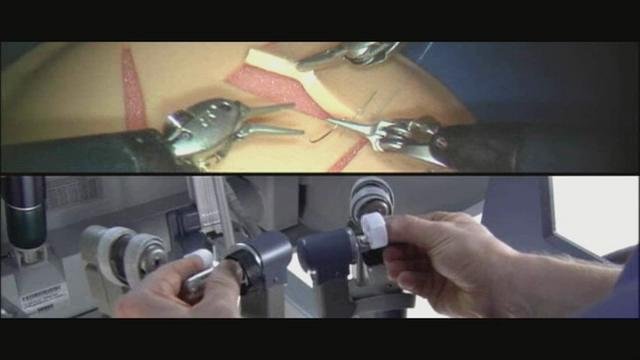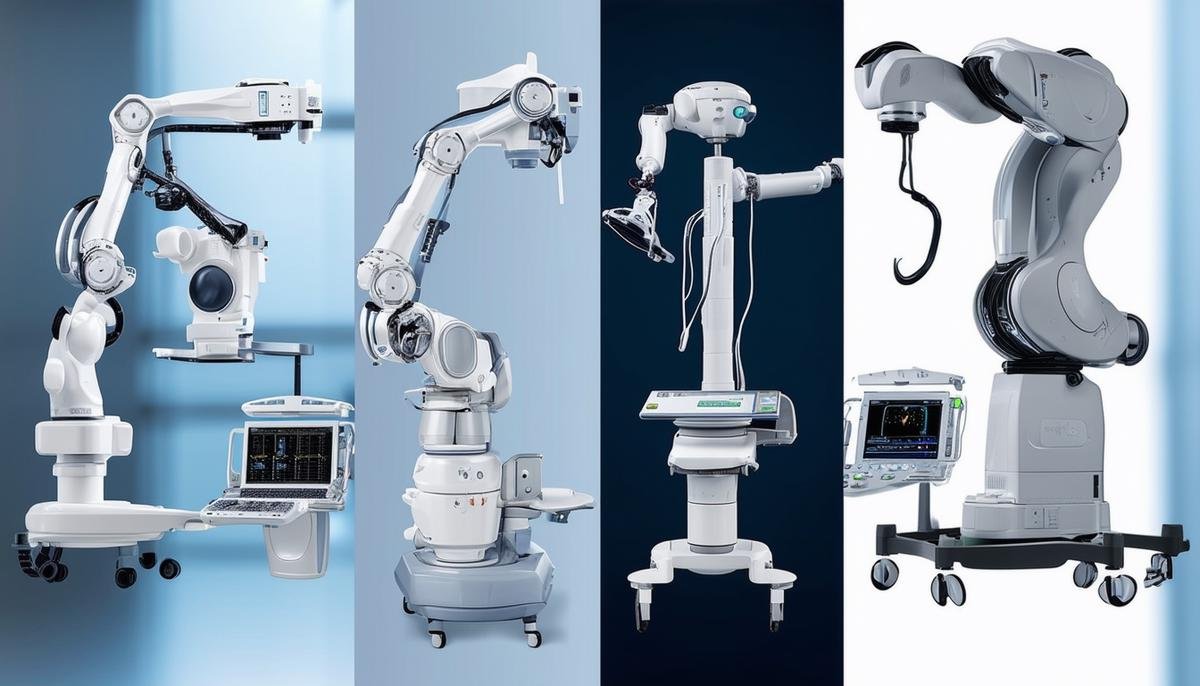Intuitive Surgical has long been a leader in robotic surgery, setting benchmarks with its da Vinci systems. This article examines the company’s innovations, competitive landscape, and the broader impact of robotic-assisted surgery on clinical and economic fronts.
Intuitive Surgical’s Dominance in Robotic Surgery
Intuitive Surgical has been leading the robotic surgery field since the 1990s. Their da Vinci systems have become synonymous with robotic surgery, with over 8,000 systems placed globally and involvement in more than 14 million procedures. In 2023 alone, they were part of about 2.3 million procedures.1
The company offers various models like the da Vinci Xi, da Vinci X, and the single-port da Vinci SP, each catering to different surgical needs. The da Vinci Xi, for instance, is noted for its advanced instrumentation and vision capabilities, including Firefly fluorescence imaging and integrated table motion features.
Their next-gen da Vinci 5 boasts:
- More than 150 design upgrades
- Significantly increased computing power
- Enhanced surgical senses
- Greater surgeon autonomy
- Streamlined OR workflows
The force-sensing technology, Force Feedback, offers surgeons real-time sensory feedback during procedures.
While competitors like Medtronic and J&J are developing systems like Hugo and Ottava, Intuitive remains the industry leader. They’ve emphasized surgeon training and support, ensuring optimal patient outcomes. Their focus on building an ecosystem around their robots, from education and training pathways to analytics solutions, has been strategic.
Intuitive’s foresight in capturing surgical data aids in advanced analytical insights for improving surgical outcomes. Their targeted commercial collaboration with J&J’s Ethicon business underscores a commitment to providing comprehensive surgical solutions.

The Evolution of the da Vinci System
The da Vinci 5 system represents a significant advancement in robotic surgery technology. Its Force Feedback feature gives surgeons real-time sensory feedback on tissue pressure, potentially reducing trauma and improving recovery times. The system’s 3D surgical imaging provides clearer visualization of the surgical field and is designed to integrate future endoscopes and vision software.
Key features of the da Vinci 5 include:
- Computing power 10,000 times greater than its predecessor
- Better integration with apps and platforms for performance review and collaboration
- Ergonomic design of the surgeon console, allowing for a broader range of working postures
- Integration of tools like surgical cameras, insufflators, and electrosurgical generators
- Ability to collect and synchronize large amounts of data for data-driven insights
These advancements position Intuitive Surgical to maintain its lead in the competitive robotic surgery market.

Competitive Landscape and Emerging Contenders
While Intuitive Surgical maintains its leadership, new players are entering the robotic surgery market. Here’s a comparison of some key competitors:
| Company | System | Key Features | Status |
|---|---|---|---|
| Medtronic | Hugo | Modular design, cloud-based Touch Surgery Enterprise platform | U.S. launch by 2025 |
| Johnson & Johnson | Ottava | Four robotic arms integrated into surgical table | Clinical trials expected in 2024 |
| CMR Surgical | Versius | Modular, mobile design for flexibility | Available in select markets |
| Vicarious Surgical | N/A | Human-like robotic arms, 3D visualization | In development |
Each company aims to differentiate itself through innovation, cost-efficiency, or specialized features. The competitive landscape is dynamic, with ongoing technological advancements and FDA approvals shaping the market.
As these companies refine their products and strategies, Intuitive Surgical’s ability to innovate and adapt will be crucial in maintaining its leading position. The coming years will be significant in determining how this interplay of innovation, marketing, and clinical efficacy unfolds in the surgical robotics field.

Clinical and Economic Impact of Robotic Surgery
Robotic-assisted surgery offers notable advantages over conventional methods. Clinically, systems like Intuitive Surgical’s da Vinci platforms have shown improvements in patient safety, procedure times, and recovery rates.
A key advantage is enhanced precision. The da Vinci system gives surgeons more control over instruments, allowing for delicate movements that may be difficult with traditional laparoscopic tools. This precision leads to fewer complications and minimized tissue trauma. The Force Feedback feature in the da Vinci 5 system provides real-time tactile feedback, further reducing tissue damage risk.
Procedure times can be shorter with robotic surgery. While initial setup takes longer, the actual surgeries can be completed more quickly once underway. Intuitive’s da Vinci 5 system integrates many tools and features to streamline operations, resulting in reduced operative times and less time under anesthesia for patients.
Recovery rates are also improved. These minimally invasive procedures often result in:
- Less post-surgery pain
- Reduced pain medication needs
- Shorter hospital stays
For example, patients undergoing robotic-assisted hysterectomies typically have faster recovery periods compared to those having traditional open surgeries.1
The economic implications are significant. While the initial investment in robotic systems is high—ranging from $1 million to $2.5 million—the long-term cost savings often justify the expense. These systems can lead to lower overall care costs due to fewer complications, shorter hospital stays, and improved resource utilization.
Integrating tools like surgical cameras and insufflators into the robotic system offers economic benefits. Hospitals can save on purchasing and maintaining multiple separate equipment pieces. This integration also improves operating room setup efficiency.
Data analytics capabilities in these systems provide feedback on surgeon performance and procedural outcomes. This data-driven analysis helps optimize procedures, reducing surgical times and costs. As more surgeries are performed using these advanced systems, hospitals can gather extensive data to refine techniques and improve outcomes.

Future Directions and Innovations in Surgical Robotics
The future of surgical robotics promises advancements that could redefine medical technology. This next phase will focus on integrating emerging technologies, expanding into new surgical domains, and increasing the influence of data analytics and artificial intelligence (AI).
AI and Machine Learning Integration
Incorporating AI and machine learning to improve procedural precision and outcomes is a promising prospect. AI algorithms can analyze surgical data to identify patterns and optimize techniques, potentially leading to better procedures and fewer complications. Predictive analytics could anticipate potential surgical challenges based on patient data, allowing surgeons to adjust their approaches more effectively.
Intuitive Surgical’s da Vinci 5 system supports advanced AI functions, enabling real-time analysis and decision support during procedures. This allows surgeons to operate with AI-powered insights, enhancing their ability to make informed decisions quickly.
Expanding Surgical Applications
Surgical robotics is expanding into new procedural applications. While currently focused on soft tissue surgeries, future robotic systems could extend into more complex surgical areas such as cardiovascular and neurosurgical operations. Systems like Intuitive’s single-port da Vinci SP are advancing single-incision surgeries, reducing patient trauma and improving recovery times.
Data Analytics and Performance Optimization
Data analytics will play a key role in surgical robotics’ future. Analyzing large datasets from robotic procedures will enable healthcare providers to:
- Benchmark performance
- Understand best practices
- Refine techniques
Intuitive’s Case Insights provides surgeons with detailed performance metrics and video analyses of their procedures.
Remote and Collaborative Surgeries
Remote and collaborative surgeries are expected to increase with the development of high-speed communication technologies. This could broaden access to specialized surgical expertise and foster global collaboration.
Competition and Innovation
Competitors like Medtronic and Johnson & Johnson are also preparing for these developments:
- Medtronic’s Hugo system: With its modular design and cloud-based analytics, it’s set to use AI and data analytics to optimize surgical performance.
- Johnson & Johnson’s Ottava platform: Aims to streamline surgeries, making it easier to integrate AI and enhanced procedural data into daily practice.

As surgical robotics progresses, systems like Intuitive Surgical’s da Vinci remain at the forefront, promising safer and more efficient surgical care. Ongoing advancements ensure that robotic-assisted surgery will continue to improve patient outcomes and transform medical practices globally.



